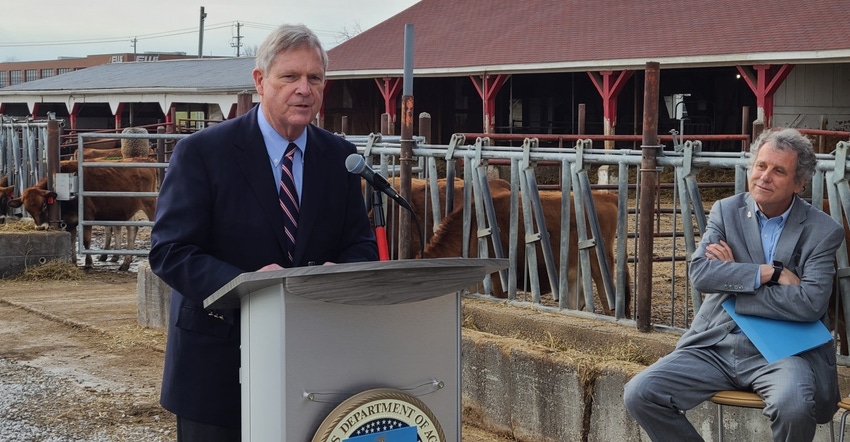
With the recent passage of the bipartisan infrastructure plan, Secretary of Agriculture Tom Vilsack joined Senator Sherrod Brown, D-Ohio, in a visit to Ohio State University Friday, December 10, and shared the benefits of the recently approved infrastructure bill as well as the need for more conservation funding for farmers in the Build Back Better bill now awaiting Senate action.
Vilsack says the money allocated to improve roads and bridges, as well as the ports and waterways, in the bipartisan infrastructure bill will help farmers get their products to market more efficiently and effectively and at a lower cost. “It allows us to maintain our competitive edge,” he says of the 20-30 percent of agricultural goods going overseas.
Brown adds the infrastructure bill coupled with what Congress is trying to advance with its Build Back Better plan will help farmers increase yields and help their bottom lines, as well as invest in biodigesters, making soils healthier and advancing new technologies like sustainable aviation fuel.
He says the $27 billion for climate-smart agriculture and expansion of farm bill conservation programs in Build Back Better “will be the biggest investment in conservation and agricultural innovation since the Dust Bowl.”
Vilsack adds that the BBB is an opportunity for the U.S. to “jumpstart an amazing amount of conservation on farms across America and will enable farmers to learn more about climate-smart agricultural practices, benefit financially from those practices and put themselves in a position to benefit the environment and also their bottom line.”
Will the Build Back Better pass in the Senate? Brown believes so.
The Senate still tentatively plans to consider the House-passed Build Back Better Act the week of December 13.
“I think it will be done by the end of the year,” he projects. “I think it’s important that the Senate vote on it. It’s going to need all the Democrat member support.”
When asked about the discussions among those Democrat party members who have yet to support the broader $2 trillion spending plan with focus on human infrastructure and climate initiatives, Brown says he and other Democrats continue to have discussions with Sen. Joe Manchin, D-W. Va., and Krysten Sinema, D-Ariz., on their concerns to the bill.
“We talk to them. We answer their objections. We compromise with them. It’s the legislative process,” Brown says.
Brown adds he’s hopeful, although not certain, that the Build Back Better bill will secure all 50 Democrat votes needed and pass before the Senate breaks for Christmas.
Ag workforce inclusion in BBB?
The ag industry continues to struggle with finding enough laborers to work within the industry.
The House bill would provide temporary work and travel authorization for most undocumented immigrants who arrived before January 1, 2011. Nearly 90% of immigrant farmworkers have been living in the United States for more than a decade, according to Farmworker Justice. If ruled by the Senate parliamentarian, Senate leaders may have to cut the provisions that offer immigration relief for undocumented immigrants as well as immigrants waiting decades for green cards.
When Vilsack was asked how to improve the workforce situation for the ag sector, he responded that it “starts with hoping the Senate parliamentarian sees the wisdom of what Senator Brown and others are trying to do in the Build Back Better bill which is to contain an opportunity to perhaps provide greater stability for that ag workforce and addressing some of the components of the Farm Workforce Modernization Act. If that provision gets to remain in the bill, that obviously would be a huge step forward in the effort,” he says.
However, if the provision has to be removed to abide by Senate rules, Vilsack says USDA will continue to work with Brown and like-minded senators to make sure that the House’s approved Farm Workforce Modernization Act can find bipartisan support in the Senate.
“There is significant Democratic support for it. I know that there are some Republican senators, as well, interested in this. We just need to make sure we get 60 votes, but hopefully the parliamentarian sees the wisdom of what we’re trying to do.”
About the Author(s)
You May Also Like






